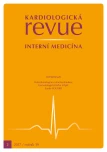The relation between blood pressure and pain – what do we know already?
Authors:
M. Koudelka; E. Sovová
Authors‘ workplace:
Klinika tělovýchovného lékařství a kardiovaskulární rehabilitace LF UP a FN Olomouc
Published in:
Kardiol Rev Int Med 2017, 19(2): 115-117
Overview
High blood pressure (BP) accounts for 7.6 million deaths around the world every year and is the most frequent known risk factor for the development of cardiovascular diseases (CVD). These are world endemic diseases and therefore it is highly important to identify the risk factors with certainty to be able to plan preventive measures. Pain is one of the risk factors causing CVD and also the most frequent reason for visiting a doctor. Studies show that chronic pain increases CVD risk and also the mortality in direct proportion. The mechanisms of mutual interaction between the cardiovascular and pain regulatory systems have not been fully explained so far. They might be explained by the activation of the sympatho-adrenal-medullary and hypothalamic-pituitary-adrenal axis. Raising awareness of chronic pain as a CVD risk factor, albeit in accordance with BMI, could have an important clinical impact.
Keywords:
blood pressure – chronic pain – acute pain – cardiovascular prevention
Sources
1. Lawes CM, Vander Hoorn S, Rodgers A. Global burden of blood-pressure-related disease. Lancet 2008; 371(9623): 1513– 1518. doi: 10.1016/ S0140-6736(08)60655-8.
2. WHO. The World Health Report, 2002: reducing risks, promoting healthy life. Geneva: World Health Organization 2002.
3. Alford DP, Liebschutz J, Chen IA et al. Update in pain medicine. J Gen Intern Med 2008; 23(6): 841– 845. doi: 10.1007/ s11606-008-0570-8.
4. Rokyta R, Höschl C (eds). Bolest a regenerace v medicíně. 1. vyd. Praha: Axonite CZ 2015.
5. Hatch JP, Schoenfeld LS, Boutros NN et al. Anger and hostility in tension-type headache. Headache 1991; 31(5): 302– 304.
6. Zimmerman L, Story KT, Gaston-Johasson F et al. Psychological variables and cancer pain. Cancer Nurs 1996; 19(1): 44– 53.
7. Kerns RD, Rosenberg R, Jacob MC. Anger expression and chronic pain. J Behav Med 1994; 17(1): 57– 67.
8. Gaskin ME, Greene AF, Robinson ME et al. Negative affect and the experience of chronic pain. J Psychsom Res 1992; 36(8): 707– 713.
9. Naranjo JR, Fuentes JA. Association between hypoalgesia and hypertension in rats after short-termisolation. Neuropharmacology 1985; 24(2): 167– 171.
10. Tsukamoto K, Sved AF, Ito S et al. Enhanced serotonin-mediated responses in the nucleus tractus solitarius of spontaneously hypertensive rats. Brain Res 2000; 863(1– 2): 1– 8.
11. Glass MJ, Pickel VM. Alpha(2A)-adrenergic receptors are present in muopioid receptor containing neurons in rat medial nucleus tractus solitarius. Synapse 2002; 43(3): 208– 218.
12. Taylor BR, Roderick RE, St. Lezin E et al. Hypoalgesia and hyperalgesia with inherited hypertension in the rat. Am J Physiol Regul Integr Comp Physiol 2001; 280(2): R345– R354.
13. Taylor BR, Roderick RE, Basbaum AI. Brainstem noradrenergic control of nociception is abnormal in spontaneously hypertensive rats. Neurosci Lett 2000; 291(3): 139– 142.
14. Taylor BK, Peterson MA, Basbaum AI. Exaggerated cardiovascular and nociceptive responses to subcutaneous Formalin injection in the spontaneously hypertensive rat. Neurosci Lett 1995; 201: 9– 12.
15. Millan MJ. Descending control of pain. Prog Neurobiol 2002; 66(6): 355– 474.
16. Maixner W. Interactions between cardiovascular and pain modulatory systems: physiological and pathophysiological implications. J Cardiovasc Electrophysiol 1991; 2: S3– S12.
17. Wei F, Dubner R, Ren K. Nucleus reticularis gigantocellularis and nucleus raphe magnus in the brain stem exert opposite effects on behavioral hyperalgesia and spinal Fos protein expression after peripheral inflammation. Pain 1999; 80(1– 2): 127– 141.
18. Myers CD, Robinson ME, Riley JL et al. Sex, gender, and blood pressure: contributions to experimental pain report. Psychosom Med 2001; 63(4): 545– 550.
19. Bruehl S, McCubbin JA, Harden RN. Theoretical review: altered pain regulatory systems in chronic pain. Neurosci Biobehav Rev 1999; 23(6): 877– 890.
20. Scheuren R, Duschek S, Schulz A et al. Blood pressure and the perception of illusive pain. Psychophysiology 2016; 53(8): 1282– 1291. doi: 10.1111/ psyp.12658.
21. Bruehl S, Burns JW, McCubbin JA. Altered cardiovascular/ pain regulatory relationships in chronic pain. Int J Behav Med 1998; 5(1): 63– 75.
22. Bragdon EE, Light KC, Costello NL et al. Group differences in pain modulation: pain-free women compared to pain-free men and to women with TMD. Pain 2002; 96(3): 227– 237.
23. Von Korff M, Crane P, Lane M et al. Chronic spinal pain and physical– mental comorbidity in the United States: results from the national comorbidity survey replication. Pain 2005; 113(3): 331– 339.
24. Schneider S, Mohnen SM, Schiltenwolf M et al. Comorbidity of low back pain: representative outcomes of a national health study in the Federal Republic of Germany. Eur J Pain 2007; 11(4): 387– 397.
25. Olsen RB, Bruehl S, Nielsen CS et al. Hypertension prevalence and diminished blood pressure-related hypoalgesia in individuals reporting chronic pain in a general population. The Tromsø study. Pain 2013; 154(2): 257– 262. doi: 10.1016/ j.pain.2012.10.020.
26. Leveille SG, Zhang Y, McMullen W et al. Sex differences in musculoskeletal pain in older adults. Pain 2005; 116(3): 332– 338.
27. McBeth J, Symmons DP, Silman AJ et al. Musculoskeletal pain is associated with a long-term increased risk of cancer and cardiovascular-related mortality. Rheumatology 2009; 48(1): 74– 77. doi: 10.1093/ rheumatology/ ken424.
28. Burns JW, Quartana PJ, Bruehl S et al. Chronic pain, body mass index and cardiovascular disease risk factors: tests of moderation, unique and shared relationships in the Study of Women'sHealth Across the Nation (SWAN). J Behav Med 2015; 38(2): 372– 383. doi: 10.1007/ s10865-014-9608-z.
29. Andersson HI. The course of non-malignant chronic pain: a 12-year follow-up of a cohort from the general population. Eur J Pain 2004; 8(1): 47– 53.
Labels
Paediatric cardiology Internal medicine Cardiac surgery CardiologyArticle was published in
Cardiology Review

2017 Issue 2
Most read in this issue
- Target blood pressure values in heart failure
- New fixed antihypertensive combinations
- Electrocardiogram and cardiac stimulation
- Pharmacotherapy of heart failure with preserved ejection fraction
